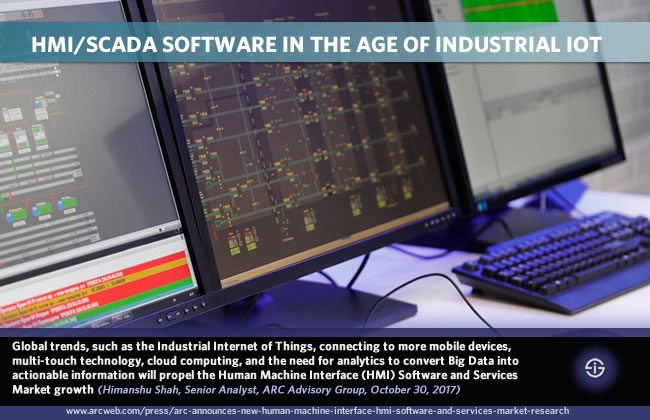A look at the present and future of HMI/SCADA software in an industrial environment of connectivity, big data, cloud, mobility, IoT, advanced analytics and the movement of intelligence towards the edge.
One of the components of SCADA systems is the HMI/SCADA software. As is the case with the role, place and future of SCADA in general, the HMI software market (HMI stands for the human machine interface) is strongly impacted by IoT and the evolutions with regards to cyber-physical systems and Industry 4.0 in general.
For some SCADA systems don’t even have a future in a world where edge computing and the shift of intelligence to the edge, the Industrial IoT, mobility, artificial intelligence, digital twins and far more evolutions (also non-technical ones) are disrupting and driving OT-intensive environments and the automation market overall, from manufacturing evolutions, changes in oil and gas to smart building evolutions.
However, that’s for a later article as the main consensus today is that, certainly in the close to middle-term future it is not a question of SCADA versus IIoT but of the combination of next generation SCADA and IoT for several reasons. Among them are the perceived need of SCADA in critical industrial processes (also think SCADA security), interoperability and scalability but in this day and age things do evolve fast, certainly when artificial intelligence and machine learning are added to IoT and other technologies.
In this article we take a close look at the evolutions with regards to SCADA/HMI software. At the bottom of this page we’ve added a few of the leading HMI software vendors and links to their sites so you can check out how they are evolving and get a feeling about where the overall market is heading.

Not all SCADA software is HMI software
First do remember that there is a difference between SCADA and HMI, whereby HMI as said is the human machine interface (which of course also needs hardware).
Although SCADA and HMI software are not the same as SCADA is the overall control system (also including hardware) and HMI software is what the operator is working with, de facto we speak about HMI/SCADA software.
The landscape of SCADA software went through a stage of integration and better control, but several vendors sell HMI software (nowadays all with web-based HTML5 editions or add-ons), historian software, reporting software, alarm software, development software and all sorts of clients in the scope of SCADA, often along with higher-level applications such as manufacturing execution systems, analytics management etc. (where the list of applications below comes in as a way to explore the landscape and offerings/visions as we added a bit of everything in the scope of HMI and SCADA software).
 Strictly speaking SCADA software is the software part of SCADA systems which comprises several types of software such as HMI software, software platforms to build SCADA applications and all the software in the overall data communication platform.
Strictly speaking SCADA software is the software part of SCADA systems which comprises several types of software such as HMI software, software platforms to build SCADA applications and all the software in the overall data communication platform.
An example of where software comes into play just on the level of data: while the HMI presents the data to an operator the data needs to be gathered from all across the process or the specific concerned facilities. To do so and relay data from remote sensors you again need various hardware and software which leverage communication protocols such as OPC enabling the data communication to the HMI.
Each vendor has a different approach. Several vendors offer HMI/SCADA suites which then could include the actual HMI software or tools to build/configure them, alarm management, data collection and real-time analytics, various forms of data integration, a plant historian, fault detection and so forth. And the market is also changing fast in the sense that vendors get acquired by larger players as we mentioned before.
The role and evolution of HMI/SCADA software as an integration and business intelligence hub
More about all that later and on our SCADA page. Now back to the evolutions with regards to the HMI/SCADA software space.
When ARC Advisory Group, which has been following the SCADA market across myriad industries and applications for a very long time announced a HMI/SCADA software evaluation and selection guide in the late Spring of 2017, the company’s VP Craig Resnick shared some views on the HMI/SCADA software evolutions in a video to explain and promote the guide (video below).

Resnick pointed to the fact that HMI/SCADA software is becoming more mission-critical, especially with new technologies such as IoT. The impact of HMI/SCADA software can be felt on the factory and plant floor through production management and IT, including communications to devices ranging for sensors to both local and cloud-based servers.
Moreover, Resnick said, other new technologies such as cloud, virtualization, mobility and analytics (and do add artificial intelligence and machine learning to that) are becoming increasingly important for end users and OEMs and thus are considerations in the selection and deployment of HMI/SCADA software.
And that’s not all: HMI/SCADA software is also increasing its role as an integration and business intelligence hub Resnick reminds. The software provides connectivity and visualization to business, engineering, supply chain and MES software systems (Manufacturing Execution Systems), which connect with, among others Enterprise Resource Planning Systems that are utterly changing as well with IoT, artificial intelligence and blockchain being key elements in next generation ERP, also called intelligent ERP or iERP by IDC.
Finally, all this comes on top of the traditional display and control role of HMI/SCADA software for plant equipment and automation systems.
The state and future of the HMI/SCADA software market: driven by new technologies
End October, 2017, ARC Advisory Group also announced its latest HMI software and services market research.
In the press release regarding the research on the Human Machine Interface software and services, the company points to several – mainly technological and data-related – drivers for the HMI software and services market that is poised to grow despite various slowing factors as mentioned by Senior Analyst Himanshu Shah.
Among these inhibitors: a slowdown in the global economy, reduced investments in the oil and gas industry, an overcapacity in the metals industries and, last but not least, the Chinese economy that isn’t growing the way many had expected.
If you look at the drivers of the Human Machine Interface or HMI software and services market, on the other hand, in the end at the very core are two elements which are pretty ubiquitous in virtually all industrial markets, industrial systems and systems that are becoming or have become an integration and/or intelligence hub in a rapidly changing landscape (just as building management systems become the digital hubs in the building space where ongoing systems integration occurs as found in the 2017 edition of the Johnson Controls Energy Efficiency Indicator).
These two core elements in the future and considerations regarding HMI software and services are:
- The user of the software (the operator) with his changing expectations with regards to user experience amid increasing mobility and the demand for new intuitive experiences as, in the scope of HMI/SCADA software abilities to connect to more mobile devices and multi-touch technology.
- The ubiquitous need for actionable information and actionable intelligence that leads us from big data to analytics to advanced analytics in the deluge of unstructured data and to artificial intelligence as the way to make sense of it and to achieve the semi-autonomous and autonomous decisions Industry 4.0 and Logistics 4.0 are pretty much about.

This brings us back to Himanshu Shah and the announcement regarding the HMI software and services market as it continues to evolve in 2018 and beyond, where Shah states, quote, “ARC’s research indicates that many global trends, such as the Industrial Internet of Things, connecting to more mobile devices, multi-touch technology, cloud computing, and the need for analytics to convert Big Data into actionable information will propel the market growth”.
SCADA has become more mature as the data and information exchange with several industrial systems on the higher levels of the industrial automation pyramid (OK, it’s not really a pyramid), from supply chain management systems, manufacturing execution systems, other operations management systems and ultimately the ERP system.
It is crystal clear that both SCADA systems and the SCADA/HMI software evolutions are influenced by the evolutions on the field level (indeed, IoT, edge computing and artificial intelligence on the edge, etc.) and the evolutions at the higher levels such as the mentioned disruption of ERP as we move to intelligent ERP and where industrial IoT and the technologies that come with it are playing a key role for the future, as are the demands for ever faster and better information flows, interoperability, security, standardization and the experience of the user.
To conclude let’s go back to that video in which Craig Resnick explains the what, why and how of the HMI/SCADA software evaluation and selection guide and talks about some of the criteria that should be taken into account when selecting a modern HMI software solution that is future fit amidst all the mentioned challenges and changes. Obviously, these criteria must fit the challenges of today and tomorrow.
Keeping in mind that there is never a one-size-fits-all solution, Resnick among others points at features, requirements and thus buyer considerations and needed insights regarding HMI/SCADA software such as:
- Understanding the technology and architecture of the considered solution.
- Understanding how the HMI/SCADA software integrates with previously mentioned systems on the level of business, engineering, supply chain, manufacturing execution systems, plant equipment and automation systems.
- Looking at the overall usage and support for all those new and crucial technologies whereby cloud, virtualization, mobile and analytics.
- Not overlooking traditional buying considerations such as the business viability and vision of the supplier, support, hardware requirements, training and services and so on.
And let’s certainly not overlook the SCADA/HMI security aspects of the software you are looking at! More in the overview of the mentioned software selection and evaluation guide.

